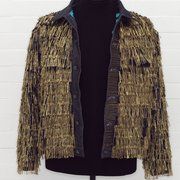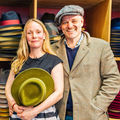Event to capture creativity of London fashion in 1980s

The Club
London’s clubs in the 1980s acted as a site for the convergence of music and fashion and provided a safe environment in which young people could experiment and mix with those of similar tastes. Fashion designer Stevie Stewart of Body Map noted that ‘each group of people, whether they were fashion designers, musicians or dancers, filmmakers or whatever, living together, going out together and at the same clubs … had a passion then for creating something new … that was almost infectious’. Examples of the resultant looks will be displayed, ranging from the exaggerated, exotic styles favoured by the Blitz crowd, through the distressed styles of Hard Times, to the eclectic mixing and individual expression of Taboo, to the dance influenced looks of acid house.
In September 1982, The Face observed a ‘hardening of attitudes in music and fashion’ that reflected the economic conditions of Thatcherite Britain: ‘Ubiquitous Levi’s worn into holes, sweatshirts serving their purpose and losing their sleeves, leather dominating everything … big boots and no socks and espadrilles … T-shirts ripped and torn’. The ‘Hard Times’ look coincided with a revival of rockabilly style in clothing and music, reflected in leather designs by Lloyd Johnson.
At Taboo, so-called because ‘there is nothing you can’t do there’, Leigh Bowery became the ringmaster of a carnivalesque nightspot, where parodying the norms of everyday life and ‘fashion’ was encouraged. Clothes designed and worn by Bowery will be on display along side fetishwear by Pam Hogg and Vivienne Westwood. Clothes by Christopher Nemeth and jewellery by Judy Blame will show how customization, DIY and re-appropriation of objects prevailed as the club look.
Michiko Koshino’s first store in Covent Garden had a dance club atmosphere and included DJ turntables to complete the effect. In 1987, she began a line of menswear called Motorking, which was worn by David Bowie and Moby. Her club designs included garments made from inflatable plastic fabric that blurred the distinction between art and fashion.
Rave and euphoric house nights, where the combination of dance music and drugs created an atmosphere in which inhibitions were totally gone, changed dress once again. Following the summer of 1987, a number of DJs began to recreate the sound and atmosphere of the Ecstasy-fuelled Ibiza dance clubs. The loose shapes of the early 1980s disappeared and a new kind of tight fitting club wear evolved that featured day-glo colours and metallic tones. This movement is represented by the designs of Rifat Ozbeck and Westwood’s silver leather ‘armoured’ jackets.
































-Ltd..jpg?tr=w-120,h-60,c-at_max,cm-pad_resize,bg-ffffff)





.jpg?tr=w-120,h-60,c-at_max,cm-pad_resize,bg-ffffff)
.jpg?tr=w-120,h-60,c-at_max,cm-pad_resize,bg-ffffff)






